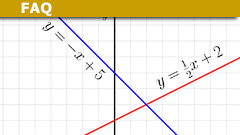What is a Linear Equation? A 5 Minute Introduction
Table of Contents
Definition/Summary
A first-order polynomial equation in one variable, its general form is [itex]Mx+B=0[/itex] where x is the variable. The quantities M, and B are constants and [itex]M\neq 0[/itex].
Equations
[tex]Mx+B=0[/tex]
Extended explanation
Since [itex]M\neq 0[/itex] the solution is given by
[tex]x=-B/M\;.[/tex]
The variable x does not have to be a number. For example, x and B could be vectors and M could be a matrix.
In this case, the condition for a solution to existing is
[tex]\det(M)\neq 0\;,[/tex]
and the solution is given by
[tex]\vec x = -M^{-1}\vec B\;,[/tex]
where [itex]M^{-1}[/itex] is the matrix inverse of M.
Another (more abstract) example, is Green’s function equation for the time-dependent Schrodinger equation. In this case, x is a Green’s function, and B is a (Dirac) delta function in time, and M is the operator
[tex]M=\left(\frac{i}{\hbar}\frac{\partial}{\partial t}-\hat H\right)\;,[/tex]
where [itex]\hat H[/itex] is the hamiltonian.
As of linear operators, see also
https://www.physicsforums.com/insights/hilbert-spaces-relatives/
https://www.physicsforums.com/insights/tell-operations-operators-functionals-representations-apart/
This article was authored by several Physics Forums members with PhDs in physics or mathematics.










Leave a Reply
Want to join the discussion?Feel free to contribute!